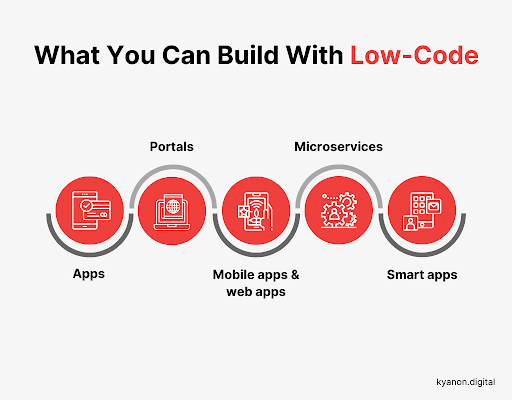Good Reasons On Picking Low-code platforms for application development
Wiki Article
The Advantages Of Developing Low-Code For Speed
Visual Development Environment (VDE):
Drag-and-Drop Interfaces: Low-code platforms provide visual tools for designing applications. Drag-anddrop components enable developers to rapidly assemble applications without having to write code.
Many low-code platforms have already-built templates and parts. This allows developers to quickly develop or prototype their applications, without needing to start with a blank slate.
Reduced Coding requirements:
Automated Coding Generation: Low-code platforms automatically generate code in accordance with the visual model created by the developers. This reduces the requirement to manually code, and speeds up development.
Reusable components: Developers can to use reusable component across multiple projects, which reduces the amount of time they're creating and evaluating code.
Collaboration streamlined:
Low-code platform tools often include versions control, testing deployment. This facilitates seamless collaboration between teams.
Citizen Development: Non-developers as well as business users can benefit from intuitive interfaces to contribute to the development of applications which can reduce bottlenecks caused by a shortage of professional developers.
Rapid Iteration & Prototyping
Fast Prototyping Developers can quickly develop prototypes to allow ideas to be tested and feedback gathered which results in faster iteration.
Simple Modifications - The visually appealing nature low-code application development allows for simpler updates and modifications that speed up the refining of applications based on user feedback.
Pre-built Integrations:
API Integrations. Low-code platform often come with pre-built connectors as well as APIs for the most popular services, which reduces the time needed to connect other systems.
Data Integration: The tools that are built in the software make it easier and accelerate the process of linking databases, data sources, and applications.
Deployment & Scaling
One-Click deployment: Many platforms that make use of low-code have an option to deploy applications, thus reducing time and effort.
Cloud-based Solutions: Cloud platforms with low-code let developers focus on the logic and functionality of their apps rather than worrying about deployment logistics.
Low-code development of applications is a more efficient method to create apps. It streamlines and automates several aspects of the procedure. This enables faster delivery and adapting to evolving requirements. Follow the top rated wavemaker.com coding for site tips including azure sql databases, develop web application, application development platforms, rapid action development, build with docker, cross platform mobile development, app dev platform, low code platforms, application development platforms, stored sql procedures and more.

Flexibility And Scalability Are Two Advantages Of Low Code Application Development
Low-code development can bring many benefits in regards to scalability and flexibility that are essential for developing applications that can be flexible enough to scale and change to the changing needs of business. Here are some of the key advantages.
Cloud-Based Deployment: Many low-code applications are cloud-based that allow applications to scale effortlessly with the cloud infrastructure. This allows businesses to handle the increased workload without worrying about server management.
Auto-Scaling Functions: Auto-scaling features can be utilized to adjust resources automatically according to demands. They ensure that performance is constant at peak times.
Flexible Architecture:
Modular Design: Low-code systems support modular application design, which means that components can be created independently test, scaled, and then redesigned. This modularity allows for greater flexibility and allows to modify or expand specific areas of the application without impacting other parts.
Microservices Integration : In support of microservices architecture, applications can be developed using loosely-coupled services to improve flexibility and scalability.
Customizable Options:
Extensibility: Low-code platforms generally allow for customized scripting and programming that allows developers to expand the functionality of applications beyond that available out-of the-box. This allows developers to satisfy their unique business requirements without any limitations.
Third-Party Integrations: The integration of APIs, third-party services or other types of services permits businesses to increase the functionality of their applications by adding new functions.
Agile Development and its deployment
Continuous delivery and deployment Low-code platforms are compatible with agile methodologies and enable continuous integration and delivery (CI/CD). This lets applications be updated and upgraded quickly as a result of feedback from users.
Iterative Development: Thanks to the nature of iterative development, low-code applications can scale and evolve gradually. This reduces the risk associated with major changes and allows for greater control over expansion.
Resource Optimization:
Effective resource management Low-code platforms optimize resources by supplying tools for monitoring and controlling application performance. This ensures that resources are utilized efficiently and are able to be scaled either up or down depending on actual needs.
Load Balancing: Integrated load balancing capabilities distribute the burden equally across servers, increasing the capacity of applications to handle heavy traffic and ensure consistent performance.
Global Reach
Multi-Region: Low-code platform deployments are typically available across multiple regions which allows businesses to offer high-quality, low-latency services to every user. This is crucial for applications that serve an international audience.
Support for Localization: The built-in support of localization allows the applications to be easily tailored for various languages and needs in diverse markets.
Updates and maintenance
Maintenance is simplified because of the modularity and visual appeal of low-code applications makes maintenance easier which allows quick fixes and updates to be implemented without lengthy downtime.
Version Control: Integrated versions control systems permit the safe release of updates and rollbacks. Previous versions can also be restored if they're needed.
Cost Efficiency:
Reduced development costs: Low-code platforms enable a reduction of the development costs by removing the requirement to code extensively. This enables applications to be expanded without a significant increase in the development cost or effort.
Pay-As-You-Go Models A lot of low code platforms have flexible pricing options for their services, including the pay-as-you go model that aligns costs with actual usage and growth. This provides the flexibility to budget.
The flexibility of low-code apps lets businesses develop strong, adaptable, scalable, and robust applications. These platforms provide quick responses to changes in demands, efficiency of resources, and continuous improvements, allowing the application to expand as a company. Read the most popular https://www.wavemaker.com/application-modernization/ for blog advice including rad development, app modernization, mobile app development platforms, app platforms, cross platform app dev, rapid action development, rapid application design, application modernisation, app development platform, develop cross platform mobile app and more.

In Terms Of Support For Vendors And Community Support, Low-Code Application Development Can Bring Many Advantages.
Low-code development platforms have distinct advantages when it comes to support from vendors and the community. These are important for successful implementations, ongoing maintenance, and continuous improvement. Here are some of the main advantages.
Comprehensive Technical Support:
Support Teams with Dedicated Support A lot of low-code platforms have dedicated support teams that can assist with technical issues, problem solving and advice. This will ensure that any issues will be quickly solved.
24/7 Support Certain vendors are accessible around the clock, which is beneficial to businesses operating in multiple time zones.
Training and Onboarding
Vendors will often offer organized programs for users including tutorials or webinars. They may also provide certification courses.
Personalized Onboarding: Many vendors offer personalized onboarding services to help new customers implement the platform efficiently and adapt it to their specific needs.
Updates and regular updates:
Continuous Improvements: Low-code companies regularly release updates with performance enhancements, new features and security patching, to ensure that the platform is up-to-date.
Feedback Integration: Vendors often integrate feedback from users into their development processes, ensuring that the platform evolves to meet the ever-changing demands of its customers.
Comprehensive Documentation:
Documentation: Comprehensive documentation is offered for all products. It includes everything from basic to the most advanced customisation. This can help users find solutions by themselves.
API References: API documentation is detailed and helps developers to integrate the platform with other systems, as well as adapt their apps.
Consulting and Professional Services
Expert Consulting: Most vendors provide consulting services for strategic planning, architecture, and complex implementations. This allows users maximize their software's capabilities.
Custom Development Services: Some providers provide custom development services to build specific features or integrations that are not available out-of-the-box.
Community Support for the Community
Active User Communities
Forums and Discussion Boards Many low-code platforms have vibrant online communities that allow users to discuss issues, ask questions, and share solutions, and collaborate on best practices.
User Groups and Meetings: Virtual and local user groups and meetups offer opportunities to learn, network, and share experiences with others.
Knowledge Sharing and collaboration:
Community-Contributed Resources: Users often share templates, modules, and extensions that they have developed, which can be reused or adapted by others, accelerating development and innovation.
Crowdsourced problem solving: The collective experience and expertise of the crowd is an excellent resource when it comes to tackling problems and coming up with inventive solutions.
Learning and Development
Community-Led Learning: Several communities host training sessions, workshops and webinars that are often run by experienced users who can provide insights and techniques that are more advanced.
Online Tutorials & Courses: Users of the community often share and create online tutorials, courses and instructions for how to perform tasks that help students learn more.
Feedback and Influence
Product Feedback Channels. Community forums usually include channels where you can provide feedback to the manufacturer. This feedback may influence the development and enhancement of new features.
Beta Testing Programs: Members of active communities might be able to take part in beta testing programs, which gives them early access to new features and a voice in influencing the evolution of the platform.
Recognition and Support
Community Recognition Programs: A lot of vendors have recognition programs that recognize the contribution of community members who are active, such as MVP (Most Valuable Professional) programs.
Peer Support Community members often offer peer support by sharing their expertise and providing guidance to users who are less knowledgeable. This helps create a more collaborative, supportive environment.
In general, the combination of solid vendor support, as well as an engaged, active community, provides a comprehensive ecosystem of support for development with low-code. This ensures that users have the knowledge, resources and collaboration opportunities, they need to be able to build and deploy their applications.
